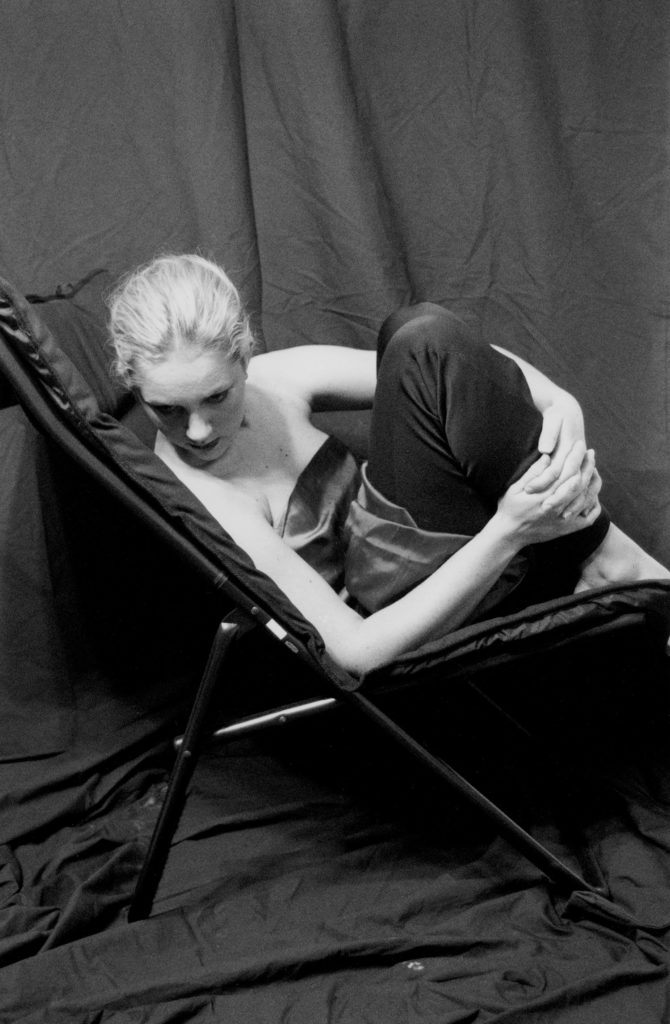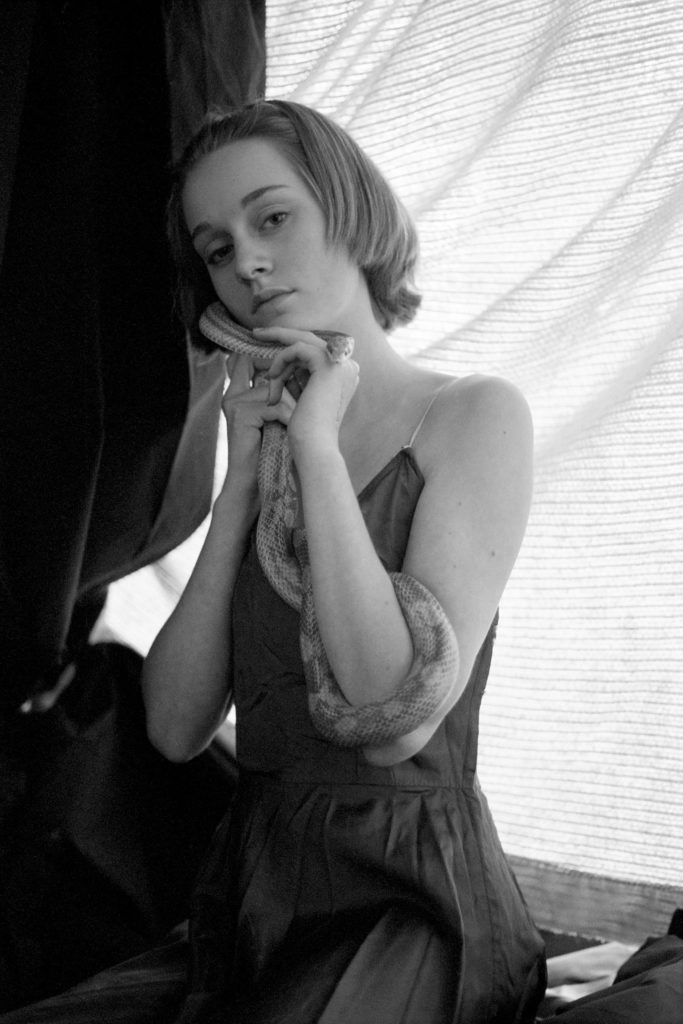Tealia Ellis Ritter lives and works in rural Connecticut. Ellis Ritter’s work contends with the intersecting roles of the photograph as personal document, familial marker of time and object with physical surface. Her interest lies in both physical and emotional exploration of the changing nature of identity and intimacy over time. She is presently engaged in a long term project documenting family members in both a representational and abstract manner, with an emphasis on the physicality and vulnerability of the human body.
What was the starting point of the series? I wonder if it has an ending as well. It seems to work very well as an ongoing archive of images, if we take into consideration the constant evolution of the family over the decades, literally and as a notion.
There really wasn’t a conscious starting point for this work, when the images actually began I was around 12 years old. Image making was then, and continues to be, a part of our life together, so the images began very naturally and were not thought of as work. It wasn’t until around 2018, when I realized that my own children were approximately the same age as my sister was when I started photographing her, that I began to think about looking at the images as a body of work. It felt to me emotionally that a large enough transition had naturally occurred in our lives over time to give the images some weight.
I don’t see an end to this work and I sincerely hope to be able to make these images until the day I die. My goal is to create an archive that follows the evolution of the family over decades and towards whatever end lies ahead of us, though I don’t know what that end will be at this point.
Would you say that your approach in image making is instinctive? Do you get attracted by the physicality of things and how your familiar people interact in daily lives?
My image making is largely instinctive but that doesn’t mean that there isn’t intellect and directionality behind the images. Editing also occupies an important space in the work.
I am definitely attracted to the physicality of being alive and the role photography plays in the expression of emotion/physicality over time: how posture, gesture, notions of identity and the willingness to collaborate evolves. For example, and this is a very rudimentary example, if you photograph a group 5 years olds at a birthday party and you tell them to pose for a photo, they all immediately begin to strike funny faces, where as if you photograph a group of 14 year olds at a birthday party, they tend to display more reserve and offer more guarded smiles. I believe that “social training” of what we will and won’t reveal or express about ourselves is so fascinating and key to understanding the human condition. That same dynamic exists in families as well. We begin to hide parts of ourselves, at the same time I believe we all want to try on different identities over the course of our lives. Consciously or subconsciously we are sorting out our ideas of self. In the end, my images are less about how my family members interact with one another and more motivated by a curiosity about how my loved ones are willing to interact with the camera and thus with myself/the viewer and with their own ideas of self. In fact, most of the images are isolated portraits, rather than group portraits. Much of the time, additional family members are just outside of view but I hope to express more direct relationships over group dynamics.
How do you achieve making personal images have universal aspects?
This was a concern of mine when I first started to consider showing The Model Family images. Would these images resonate with anyone other than my family members? I personally love images of families other than my own, this applies to both the work of artists like Harry Callahan, Emmet Gowin, Seiichi Furuya, Tina Barney and numerous others, as well as just simply exploring someone’s family album. We are all curious about how other people live. But beyond this, my images touch on some very general themes; love, isolation, togetherness, physicality, aging, death, life, joy, laughter, pain. We all experience these things. I am also conscious that in some ways my family is unique and I hope that I have expressed that as well. As a group we are all creatives, though my father was an engineer professionally, he was an avid photographer, my mother is a painter/sculptor and my sister is a furniture designer. We lived in the country by a lake with very little around us, in a house filled with animals, so it was a somewhat unconventional existence. I have tried to create some of that same freedom and sense of abandon for my own children that now are a part of the images. It is my hope that while the images register on a general emotional level, that viewers are also able to feel that they are engaging in the life of a specific group of individuals.
In The Model Family, as well as in your previous works, you are interfering with the place of women in modern society. If I ask you to do a brief recursion in the history of photography, which related pieces would you pick as the most significant?
Thank you, I love this statement. I definitely want to interfere with the place women have traditionally occupied in modern society. My father was very adamant when I was growing up that girls could do anything that boys could do and to own the voice that you have to stand up for truth and pursue with gustto whatever your passion may be, even if it doesn’t fit with society’s norm.
The thing about the history of photography is that it has largely been written by men, thus I have no doubt there are countless female photographers that created work that we will potentially never know about. Think about the intellectual capital that is lost everyday around the world because of notions of who an individual should or shouldn’t be. It’s really tragic.
“Social training of what we will and won’t reveal or express about ourselves is so fascinating and key to understanding the human condition. That same dynamic exists in families as well.”
When I think back on my education in photography, most of the artists we studied were men. So, it is largely as an adult that I have re-educated myself and thought more about the specific impact of female photographers. Specific pieces are difficult to choose but Dorothea Lange’s work obviously comes to mind as pivotal to the history of photography, as well as the work of Diane Arbus, Carrie Mae Weems, Sally Mann and Sophie Calle. But lately I have really been interested in artists like Ana Mendieta, Hannah Wilke and Annette Messager, all of whom worked with photography as one tool in their art making process. I should mention many of these women are alive, still working and creating the history of photography. I am also really excited about the younger generation of women working in photography, artists like Carmen Winant, Deana Lawson, LaToya Ruby Frazier, Talia Chetrit, Lindley Warren Mickunas and Elizabeth Hibbard. I’m just so thrilled to be working at this moment in history and exist amongst such powerful female voices.
Do you intend to create a photobook for this series? The numbered separators in your website presentation stand for chapters?
I would love to publish a book at some point. I want to find the right publisher for the work and so I am taking my time with that process. The work is so much larger than what has been seen so far publicly, that on many levels I am still trying to digest it. I do think about the work in terms of “chapters,” but I think these chapters can be organized in a number of different ways: chronologically, by individual, by topic or by loose narrative. I hope the work can function a bit like memory, in the sense that it is organized and reorganized as our lives evolve and our perspectives shift. So maybe there will be more than one book in the end, fingers crossed! Also, my big dream is to eventually publish a book of my father’s photographs of our family that leads into my images of family. This would give two different perspectives on the same group of people and span almost 50 years at this point. I think it would be really powerful.
Please share with us some of your favourite photo books you rivisted the last days in quarantine. Also, would you do the same for music records?
I have found excitement/inspiration in so many photo books over the quarantine but a few that I have returned to repeatedly are Carmen Winant’s, “My Birth,” and “Ana Mendieta, Earth Body.” I also look at a lot of work that is not photographic. Last night I was reading a book about JB Blunk, a sculptor from Inverness, California. I can really relate to the philosophy that he approached his work with. Art was part of every aspect of his life, it didn’t exist as a separate activity, it happened all around him. As far as the music I’ve been listening to during quarantine, I mostly listen while printing in my darkroom so it tends to either fit the tone I am trying to create in the image or be quite loud in order to make my body want to keep moving after a long day of standing, dodging, burning and processing prints in trays. These albums have been on repeat in the darkroom, Yola “Walk Through Fire,” Hole “Celebrity Skin,” as well as a good dose of Kanye West and Kid Cudi with some Guns N’ Roses and White Stripes thrown in.
One last thing, in your art making (perception of art in general), what would be the biggest difference between the early stages of your career and the present?
The biggest difference on a personal level is that I care just a little less now about what other people think of my work at any given moment. I have realized that art trends work in cycles and what is popular at one moment may not be popular the next. It’s important to stay true to your own path as an artist. Don’t get me wrong though, I still feel really happy and excited when people are into the work!
On a cultural level, I hope that what is changing/changes in the future is who has the privilege of writing the history of art. We need to increase the diversity of voices in positions of power on every level from the heads of institutions, to the gallery owners, the curators, the instructors, to what communities have access to art and art education.
More in her website

















